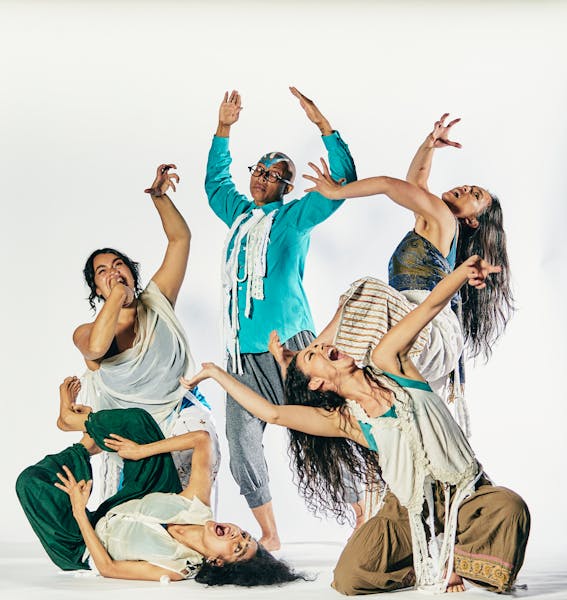In a nondescript building not far from St. Paul's historic Frogtown and Rondo neighborhoods, Ananya Chatterjea strives to promote social justice through the power of dance.
A University of Minnesota professor, Chatterjea founded Ananya Dance Theatre in 2004. Since 2018, her studio's home has been across the Green Line tracks from Gordon Parks High School and the High School for Recording Arts.
Eye On St. Paul recently visited with Chatterjea to talk about her work. This interview has been edited for length and clarity.
Q: Tell us about you.
A: I am a contemporary choreographer [who grew up in India] and came to the U.S. for guided studies in dance. I was really interested in what a contemporary dance form for social justice would look like. I did not get the answer I was looking for, so I continued looking. I got a Ph.D. at Temple University, and after that I got a job at the University of Minnesota.
Q: Why start your own dance company?
A: I really believed in the social justice mission. That's how I describe my work. For me, dance is made to be trained differently. With a different mindset. I have to remember I'm not trying to wow people [with dance alone]. What I'm trying to do is, "How can I leave you with this story?" The mission of justice choreography is to move hearts. People don't come to justice movements for money. They don't come because of fame.
Q: You didn't start this to become rich?
A: [laughs] Wrong discipline. People come because their hearts are moved. To make — to imagine — a better life for the next generation. Because no change comes with just one person, right? It comes [from us] together.
I have social justice advocates ask me, "What change is going to come from that?" I say, "That's not my job. I'm an artist." In my work, I create a groundswell of questions that then stay in people's minds long after they've left the theater.
Q: What does this do for your dancers?
A: The dancers are also asking the same questions, right? Because every time I embark on a particular theme, I go deeper and deeper. And the stories I am trying to imagine sit in my cells, they change my DNA. It's the same for other artists.
Q: Who is attracted to dancing for social justice?
A: The willing. Because, again, it's not a dance about the personal. First of all, it's an ensemble company, which means we spend a lot of time learning how to support each other as we are moving through it.
Q: You have no prima ballerina here?
A: No, there is not. If you come to the show, you will see that each artist has a particular role, and they shine in it. And then they are part of a group. This kind of notion that everyone is seen in their own light, and they are part of a group that shines light. And for me, that's a way of living.
Q: Tell me a little about your most recent production [Nün Gherāo: Surrounded by Salt at St. Catherine's University, Sept. 30-Oct. 1].
A: This is a story that remembers a terrible massacre that happened in my home state [West Bengal] in 1979. I was a child, and it was completely covered up. A group of refugees was murdered, mercilessly, by the government. The refugees came from Bangladesh, and it was really, really heartbreaking. It stuck with me because I remember it was spoken of in whispers.
Q: What are the themes?
A: Remembering history and life lost. And holding people who were lost close to our heart.
Q: Tell me about your community involvement.
A: We've had collaborations. Four years ago, we did an all-night performance in the parking lot right across, which was about Rondo. It was in collaboration [with another artist] talking about the pollution in Rondo. There were dancers in this glass box, filled with fog, and then they slowly perished one after another. We've [also] had an open house. We've done classes. Through the pandemic, we were working with the High School for Recording Arts and Gordon Parks and students there.
Q: Why is it important to have these relationships with your immediate community?
A: You know, I think it's about the place of art. Dance has a lot of functions. It certainly belongs in beautiful theaters where we can bring visions to life. But it also belongs right here.
Q: People can see you through that big picture window. Was that intentional?
A: Dance is in the middle of life and that has always been my intention. I actually think that if all of us were dancing together, we'd have to find a way to not step on each other's toes. People have many different ways of moving. How can we all dance together without running into each other?
Q: Where do you see yourself in another five years?
A: Right here, doing what I'm doing. I really hope that after I am done, the next generation can keep this going. I hope it always remains embedded in justice. I hope they can keep building. That's how movements happen.

Souhan: Fans turned Game 1 into something special. Now bring on Game 2

Meet the West Sider taking the helm at Neighborhood House, helping new arrivals find a better life
Robbinsdale shelter-in-place alert accidentally sent countywide
Developer of St. Paul's Keg & Case food hall declares bankruptcy

